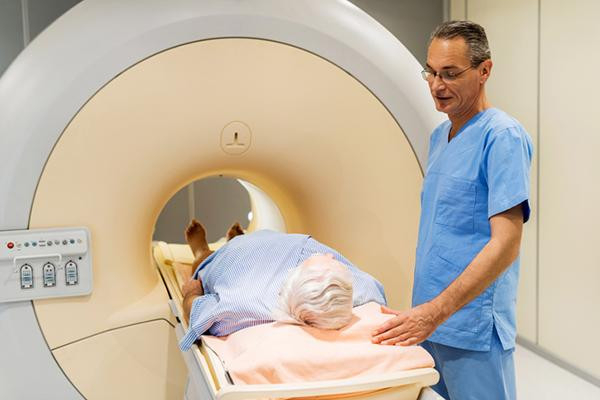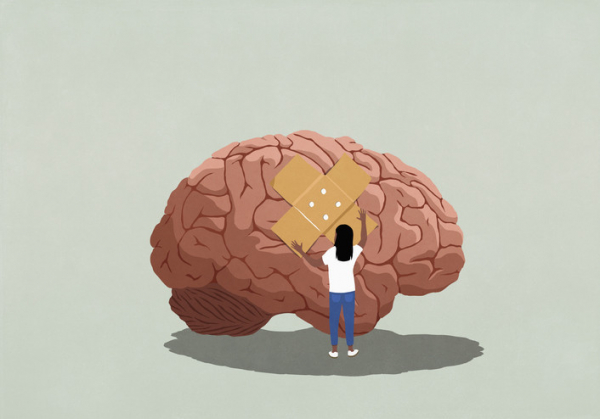
Could imaging scans replace biopsies during prostate cancer screening?

Abnormal results on a prostate-specific antigen (PSA) screening test for cancer are typically followed by a systematic biopsy. During that procedure, doctors use a long needle to extract roughly a dozen samples from the prostate while looking at the gland on an ultrasound machine. Those samples can then be checked for cancer under a microscope.
Limitations and concerns
But systematic biopsies can be problematic. A major concern is that they overdiagnose low-grade, slow-growing tumors that might never become life-threatening, thereby leading to unnecessary treatments.
Researchers are seeking alternatives to the systematic biopsy in men flagged by PSA screening. One option is to start with a magnetic resonance imaging (MRI) scan of the prostate, and then focus the biopsy only on areas that look suspicious for cancer. This is called an MRI-targeted biopsy, and it’s becoming increasingly common.
Could an MRI miss early-stage cancer that later turns out to be incurable? This is an outstanding worry, especially since systematic biopsies sometimes find newly-forming cancer that MRIs aren’t yet able to detect. Indeed, systematic and targeted biopsies are often given together to boost the odds of finding clinically significant disease that may need immediate treatment.
Methodology
Now, a large Swedish study provides encouraging evidence favoring the MRI-only approach.
The team invited 38,316 men ranging from 50 to 60 years in age to undergo PSA screening. If a man’s PSA level was 3.0 nanograms per milliliter (ng/mL) or higher, then he was enrolled into the study. The investigators wound up with 13,153 men who were randomly distributed between two groups:
- Systematic biopsy group: All the men in this group got a systematic biopsy plus an MRI. If a man’s MRI was positive for suspicious lesions, then he also got a targeted biopsy.
- MRI-targeted biopsy group: All of the men in this group got an MRI, but none got a systematic biopsy. Men with suspicious lesions on MRI got a targeted biopsy.
This initial screening round was followed by repeat screening rounds — all following the same protocols — at two-, four-, and eight-year-intervals.
What the study showed
After a median follow-up of 3.9 years (starting from and including the first screening round), prostate cancer had been detected in 185 men from the MRI-targeted group and 298 men from the systematic biopsy group. Systematic biopsies generated more clinically insignificant cancer diagnoses — 159 compared to 68 in the MRI-targeted group. During the first screening round, “The risk of such a diagnosis was 51% lower in the MRI-targeted biopsy group than the systematic biopsy group,” the authors wrote.
The authors emphasized that omitting biopsies in patients with MRI-negative results cut diagnoses of clinically insignificant cancer, meaning cancer that is slow-growing and may never need treatment, by more than half. “And importantly, the associated risk of detecting clinically significant cancer during follow-up and at later screening visits was very low in both groups,” said Dr. Jonas Hugosson, chief urologist at the University of Gothenberg and the study’s first author. “A total of 14 such cases (0.2 % of men who participated) were diagnosed in the systematic biopsy group and eight (0.1 %) in the MRI-targeted biopsy group.”
Commentary from experts
“This study provides encouraging — though very early — data that supports the increasing use of MRI as the first diagnostic modality, following evaluation of an abnormal PSA value,” said Dr. Marc Garnick, the Gorman Brothers Professor of Medicine at Harvard Medical School and Beth Israel Deaconess Medical Center, and editor-in-chief of the Harvard Medical School Guide to Prostate Diseases. “The practice of not automatically going to prostate needle biopsy when an abnormal PSA is detected has gained in popularity in Europe, and this study may help increase its usefulness in the United States.”
“While these results are encouraging, the decision to omit biopsy in men with a negative MRI must be individualized based on the risk of detecting prostate cancer,” added Dr. Boris Gershman, a urologist at Beth Israel Deaconess Medical Center and an assistant professor at Harvard Medical School focusing on prostate and bladder cancer. “For example, biopsy may still be considered in men with markedly elevated PSA, even if the prostate MRI does not identify any lesions.”
About the Author

Charlie Schmidt, Editor, Harvard Medical School Annual Report on Prostate Diseases
Charlie Schmidt is an award-winning freelance science writer based in Portland, Maine. In addition to writing for Harvard Health Publishing, Charlie has written for Science magazine, the Journal of the National Cancer Institute, Environmental Health Perspectives, … See Full Bio View all posts by Charlie Schmidt
About the Reviewer

Marc B. Garnick, MD, Editor in Chief, Harvard Medical School Annual Report on Prostate Diseases; Editorial Advisory Board Member, Harvard Health Publishing
Dr. Marc B. Garnick is an internationally renowned expert in medical oncology and urologic cancer. A clinical professor of medicine at Harvard Medical School, he also maintains an active clinical practice at Beth Israel Deaconess Medical … See Full Bio View all posts by Marc B. Garnick, MD

Concussion in children: What to know and do

Concussion is one of the most common injuries to the brain, affecting about two million children and teens every year. It is a particular kind of injury that happens when a blow to the head or somewhere else on the body makes the brain move back and forth within the skull.
It’s possible to get a concussion after what might seem like a minor injury, like a forceful push from behind, or a collision between two players in a football or soccer game.
What are the signs and symptoms of concussion?
Because the injury may not seem that significant from the outside, it’s important to know the symptoms of a concussion. There are many different possible symptoms, including
- passing out (this could be a sign of a more serious brain injury)
- headache
- dizziness
- changes in vision
- feeling bothered by light or noise
- confusion or feeling disoriented
- memory problems (such as difficulty remembering details of the injury) or difficulty concentrating
- balance or coordination problems
- mood changes.
Some of these are visible to others and some are felt by the person with the concussion. That’s why it’s important to know the signs and to ask all the right questions of a child who has had an injury.
Sometimes the symptoms might not be apparent right away, but show up in the days following the injury. The CDC’s Heads Up website has lots of great information about how to recognize a concussion.
How can further harm to the brain be avoided?
The main reason it’s important to recognize a possible concussion early is that the worst thing you can do after getting a concussion is get another one. The brain is vulnerable after a concussion; if it is injured again, the symptoms can be longer lasting — or even permanent, as in cases of chronic traumatic encephalopathy (CTE), a condition that has been seen in football players and others who have repeated head injuries.
If there is a chance that a child has had a concussion during a sports competition, they must stop playing — and get medical attention. It’s important to get medical attention any time there is concern about a possible concussion, both to be sure there isn’t a more serious brain injury, and to do a good assessment of the symptoms, so that they can be monitored over time. There are some screening questionnaires that are used by doctors that can be used again in the days and weeks after the concussion to see how the child is improving.
What helps children recover after a concussion?
Experts have struggled with figuring out how to protect the brain after a concussion. For a long time, the recommendation was to rest and do very little at all. This meant not doing any exercise, not going to school, not even reading or watching television. As symptoms improved, the restrictions were lifted gradually.
Over time, though, research showed that not only was this much rest not necessary, it was counterproductive. It turns out that getting kids back into their daily lives, and back into being active, is safe and leads to quicker recovery. Experts still recommend rest and then moving gradually back into activities, but the guidelines are no longer as strict as they once were.
One important note: A medical professional should guide decisions to move from rest to light activity, and then gradually from there to moderate and then regular activities based on how the child is doing. This step-by-step process may extend for days, weeks, or longer, depending on what the child needs. Parents, coaches, and schools can help support a child or teen as they return to school and return to activities and sports.
Some children will be able to get back into regular activities quickly. But for others it can take weeks or even months. Schools and sports trainers should work with children to support them in their recovery. Some children develop post-concussive syndromes with headache, fatigue, and other symptoms. This is rare but can be very disabling.
How can parents help prevent concussions?
It's not always possible to prevent concussions, but there are things that parents can do:
- Be sure that children use seat belts and other appropriate restraints in the car.
- Have clear safety rules and supervise children when they are playing, especially if they are riding bikes or climbing in trees or on play structures.
- Since at least half of concussions happen during sports, it’s important that teams and coaches follow safety rules. Coaches should teach techniques and skills to avoid dangerous collisions and other injuries. Talk to your child’s coaches about what they are doing to keep players safe. While helmets can prevent many head injuries, they don’t prevent concussions.
About the Author

Claire McCarthy, MD, Senior Faculty Editor, Harvard Health Publishing
Claire McCarthy, MD, is a primary care pediatrician at Boston Children’s Hospital, and an assistant professor of pediatrics at Harvard Medical School. In addition to being a senior faculty editor for Harvard Health Publishing, Dr. McCarthy … See Full Bio View all posts by Claire McCarthy, MD

The BEEP program: Keep your balance

Balance is a skill you don’t think about until you really need it — like when you lose your footing and have to perform an exotic improv dance to keep from hitting the ground. But don’t wait until your sense of balance fails before you give it proper attention. As we age, balance can sharply decline, often with little warning. An exercise program called BEEP can help.
How you keep your balance
While keeping proper balance may seem simple, it involves a complex system with many moveable parts. Whenever you move, your eyes and brain process information about your surroundings. Your feet detect changes in the terrain. Your arms swing to keep you stable, and your lower-body muscles and joints generate rapid power so you can move forward, stop, and change directions.
Unfortunately, this system works less effectively over time. The sensation of our bodies moving through space is not as crisp, and information travels more slowly between the body and brain. Muscles become weaker, and joints lose flexibility.
Any breakdown in your balance system increases your risk of falls, which can cause hip fractures, broken bones, and head injuries.
“Doing more balance exercises and activities can keep your sense of balance in good shape, but you also want to focus on multifaceted movements that work on all the elements of your balance system,” says Dr. Brad Manor, associate director of the Mobility and Falls Translational Research Center with Harvard-affiliated Hebrew SeniorLife.
There are many kinds of balance exercises. Science has not tapped any specific ones as the best; however, some have stood out in many balance-related studies.
For instance, a 2016 study in the journal Gerontology and Geriatric Medicine found that a specific Balance-Enhancing Exercise Program (called BEEP for short) improved balance skills among adults ages 60 to 80. Study participants did better on both solid and uneven surfaces, and increased their walking speed and overall confidence.
Focus on three exercises to improve balance
The BEEP program focused on three exercises: squats, heel and calf raises, and one-legged standing. “These types of exercises increase both the physical and cognition skills needed for better balance,” says Dr. Manor. “Plus, they mimic movements of everyday life.”
He recommends adding these to your regular workouts or doing them daily on their own.
Squats. Stand with your feet shoulder-width apart. Bend your knees and imagine you are sitting down on a stool. Lower down until your thighs are parallel to the ground, or as far as is comfortable. Keep your weight on your heels. Extend your arms forward or place your hands on a chair, counter, or table for stability. Pause for a second or two, then rise back to the starting position. Do this up to 10 times.
Heel and calf raises. Stand with your arms crossed over your chest and lift your heels, so you rise up on your toes. Hold this position for up to 10 seconds, or as long as possible, and then lower your heels. Do this five to 10 times. If you need support, hold on to a door frame, a table, or another sturdy object. You also can place your hands flat on a wall.
One-legged standing. Stand tall and place your hands on your hips or hold on to a table or chair for stability. Then raise one leg, so your foot is about six to 12 inches above the floor. Keep your gaze straight ahead. Hold for 20 to 30 seconds. Repeat on the other leg. Go back and forth three to five times.
You also can perform these exercises with your eyes closed to work on coordination and concentration. Another option is to “distract” yourself by doing unrelated cognitive tasks — count backward, name words that begin with the same letter, or make a mental supermarket list.
“Balance is definitely a use-it-or-lose-it skill,” says Dr. Manor. “But if you work on your balance continuously, you are almost guaranteed to see improvements.”
About the Author

Matthew Solan, Executive Editor, Harvard Men's Health Watch
Matthew Solan is the executive editor of Harvard Men’s Health Watch. He previously served as executive editor for UCLA Health’s Healthy Years and as a contributor to Duke Medicine’s Health News and Weill Cornell Medical College’s … See Full Bio View all posts by Matthew Solan
About the Reviewer

Howard E. LeWine, MD, Chief Medical Editor, Harvard Health Publishing; Editorial Advisory Board Member, Harvard Health Publishing
Dr. Howard LeWine is a practicing internist at Brigham and Women’s Hospital in Boston, Chief Medical Editor at Harvard Health Publishing, and editor in chief of Harvard Men’s Health Watch. See Full Bio View all posts by Howard E. LeWine, MD